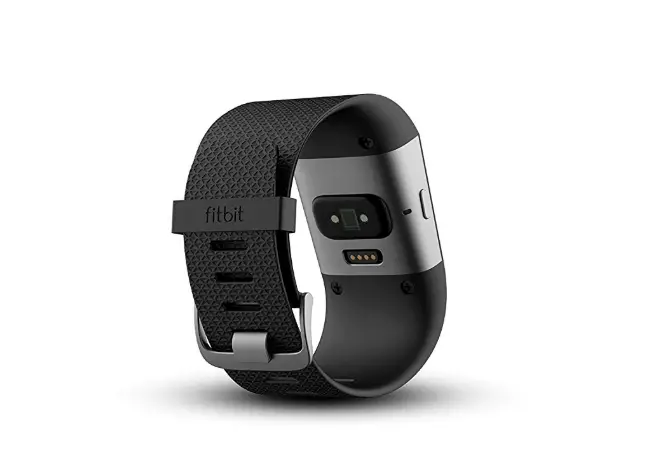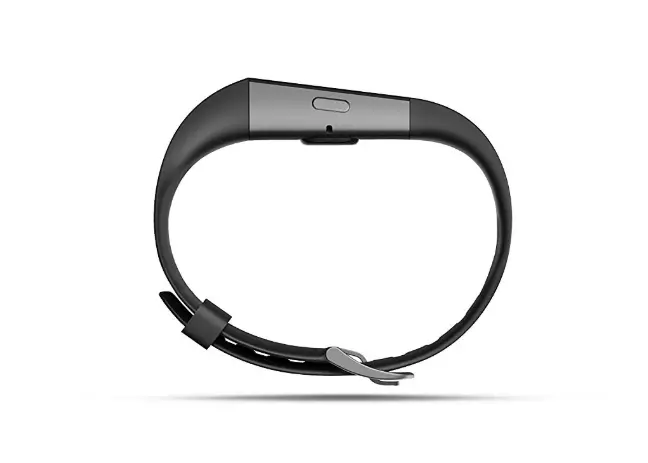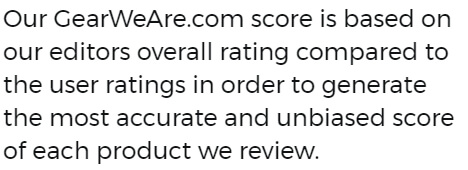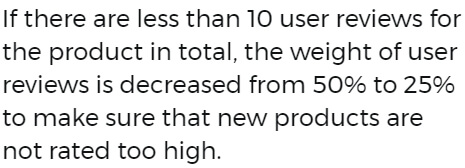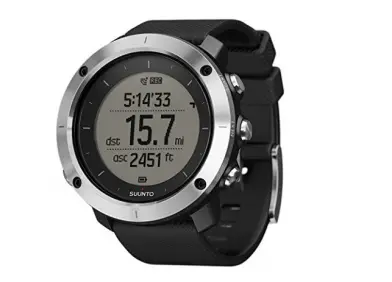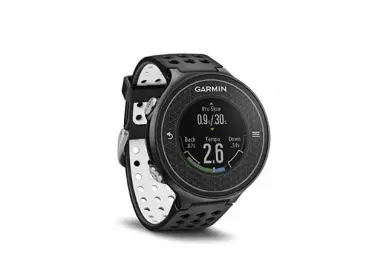Fitbit Surge
Fitbit Surge Review Facts
Also known as a ‘super watch’ by the company behind Surge, the Fitbit Surge offers a number of features and performs well. It gives its best to compete with other popular modern-day fitness trackers with a built-in heart monitor, GPS, and real-time work out data. Some may even think it a winner once features versus price are considered. If you are willing to spend, the Garmin Forerunner 920XT or Basic Peak might be on your Christmas list but decide on that after you’ve found out what the Fitbit Surge can do.
Editor's Pros & Cons
Pros
- Has the ability to track your GPS-mapped runs even when you do not have your phone with you
- Lets you control music on the run and helps you enjoy many smartwatch features
- Possible to receive SMS and phone calls while running with a quick swipe of the screen
- Comes equipped with a reasonably accurate heart rate monitor with different heart rate zones for different activities
Cons
- GPS system works fine, but it is possible to experience errors every now and then
- Design is not capable of competing with other modern-day fitness trackers and watches
- Steps count feature looks good on paper but gives inaccurate results
- Battery time is good but is not what the company claims
Design and Build Quality
There is a choice of three colors, blue, black or a bright tangerine that wouldn’t get lost at the gym. Not sure about tangerine with a business suit but who wears a suit working out? Whatever color, the Surge looks good on the wrist, like you mean business. It’s big, bigger than the Fitbit Charge and if that’s not an issue, you will like the build quality too. Three physical buttons make it user-friendly. Everything can be set from them, from GPS to work out timers, adding greatly to the devices overall usability
The new watch clasp is an improvement, as the old one was not that secure and there was always a risk of losing your fitness tracker. Overall, the design is good, but it is a personal preference because many people think that its big size and square look make it look like a dated "80s digital watch", but others love the fact that the watch looks solid on the wrist and does its job well too.
The new watch clasp is an improvement, as the old one was not that secure and there was always a risk of losing your fitness tracker. Overall, the design is good, but it is a personal preference because many people think that its big size and square look make it look like a dated "80s digital watch", but others love the fact that the watch looks solid on the wrist and does its job well too.
Comfort
It is a chunky fitness tracking watch, so it takes time getting used to it. Though it is not that heavy and is around 2.7oz only, you find it a bit uncomfortable during the first few days of use. The elastomer polymer band is a good addition, as it is comfortable and does not irritate your skin either.
Display
There might be nothing revolutionary about the touch-sensitive monochrome display but it does the job. The screen is responsive and swiping makes cycling through data easy enough. It is a clear read in daylight due to the 1.25-inch reflective screen and a light makes it usable in the dark. The LED stays switched on for data reading on the go and even though it may damage battery life, it means keeping count of steps, active minutes or heart rate is such a chore. All useful features.
A good thing about the display is that the Surge comes with a slightly canted screen, which is nice because it makes checking the stats mid-run a breeze. When running, most of your screen will be dedicated to overall time and distance. It means that only the bottom bar is swipe-able between average pace, HR, steps, clock, pace, and calories. You may notice that it is a bit tricky at times to swipe, but the good thing is that it makes it difficult to skip between different stats.
A good thing about the display is that the Surge comes with a slightly canted screen, which is nice because it makes checking the stats mid-run a breeze. When running, most of your screen will be dedicated to overall time and distance. It means that only the bottom bar is swipe-able between average pace, HR, steps, clock, pace, and calories. You may notice that it is a bit tricky at times to swipe, but the good thing is that it makes it difficult to skip between different stats.
Ease of Use
It may take some time to feel comfortable wearing this chunky watch, but you will never have a hard time learning to use it properly. In most cases, you just need to slap it on your wrist, go to the menu to pick the "Run" option, select Treadmill or Free run, and off you go.
Heartrate Monitor
One of the top selling points for Fitbit Surge is that the heart rate monitor is always on and monitoring. What really sets it apart from similar devices is its proprietary PurePulse optical heart-rate technology. LED sensors under the wristband work at 1-second intervals and can detect slight changes in blood volume along with capillary sizes so that constant heart-rate calculations can be displayed. They light up but are totally safe.
Fitness Tracking
The Surge helps you keep track of how many calories you burn in a workout session. It also gives you info about your workout intensity through interactive graphs and charts. They are easy to read and help you manage your workouts and plan your next one efficiently. The Surge alerts you to consider changing your work out strategies while you are working out.
Based on your maximum heart rate it suggests three zones to really make your work out successful. They are the Fat Burn Zone, for when your heart rate is around 50-69% of your maximum heart rate, the Cardio zone with heart rate close to 70-84 and the Peak zone for when your heart rate greater than 85% of your max heart rate. All good information if you've just started out in the fitness world.
Based on your maximum heart rate it suggests three zones to really make your work out successful. They are the Fat Burn Zone, for when your heart rate is around 50-69% of your maximum heart rate, the Cardio zone with heart rate close to 70-84 and the Peak zone for when your heart rate greater than 85% of your max heart rate. All good information if you've just started out in the fitness world.
Waterproofing
If you're interested in wearing the Surge while taking a shower or simply swimming, don't. Even though the data suggests that the fitness track is water resistant up to 5ATM, you’ll be better off keeping it away from water. The company just does not recommend it. It is strange but that’s how it is.
Sleep Activity Tracking
The Surge claims to track your sleep activity quite efficiently, and it is certainly right up there with other top fitness trackers in this regard. It tracks sleep data daily and does it automatically, so no need to input data manually.
There are other more accurate trackers that log accurate light sleep/wake/deep sleep stats, such as the Jawbone Up24, but the real issue is that you have to set the sleep mode before going to bed. No such issue is there with Fitbit Surge, which serves as a good selling point. Moreover, Fitbit has already introduced Sleep Schedule, a feature that helps you decide when to wake up and go to bed for a healthy lifestyle.
There are other more accurate trackers that log accurate light sleep/wake/deep sleep stats, such as the Jawbone Up24, but the real issue is that you have to set the sleep mode before going to bed. No such issue is there with Fitbit Surge, which serves as a good selling point. Moreover, Fitbit has already introduced Sleep Schedule, a feature that helps you decide when to wake up and go to bed for a healthy lifestyle.
Altimeter
The addition of an altimeter means that you can now count the number of floors you end up climbing in a single day. You may not always need that information, but nevertheless, that's a stat and available only a few select Fitbit models.
Steps Counting
The Fitbit Surge seems to be a great choice for anyone looking for a way to calculate steps and count calorie burn. In most tests, it has proven quite accurate. There were some minor discrepancies, but the Surge was quite in line with other trackers. The algorithm used to calculate steps seems to work efficiently to prevent inaccurate readings.
Navigation
The good thing about the GPS is that it is capable of working and tracking satellite without your phone. So there is no real need to carry your phone just to make the GPS on your fitness tracker work. However, many tests have confirmed the Surge takes quite some time to connect to a satellite, but it does not disappoint you regarding the accuracy of the data.
Another good feature is the ambient light sensor that serves well during early morning runs. Using GPS tracking during our run, the tracker showed the running time in big numbers along with the total distance covered at top of the display. It was a little awkward to read at a glance and perhaps a better way to show the data would be better.
It is worth mentioning that even though the GPS is not the most accurate as compared to other modern-day trackers, you will not witness those GPS errors quite frequently though.
Another good feature is the ambient light sensor that serves well during early morning runs. Using GPS tracking during our run, the tracker showed the running time in big numbers along with the total distance covered at top of the display. It was a little awkward to read at a glance and perhaps a better way to show the data would be better.
It is worth mentioning that even though the GPS is not the most accurate as compared to other modern-day trackers, you will not witness those GPS errors quite frequently though.
Best Applications
The Fitbit Surge comes equipped with a variety of features, so you can use it while engaging in a diverse range of activities. You can use it in the gym to track calorie burn. You can wear it while biking, running, weightlifting, hiking, spinning, circuit training, and kickboxing. It will also work efficiently to track data when you are doing yoga, using your elliptical machine, attending your Pilates or boot-camp class, or doing martial arts. In short, you can use it while doing a variety of activities, but avoid swimming because of the reason mentioned already.
Battery Life
As mentioned already, the screen stays on, so it definitely lowers the battery life a little, but as an issue, it won’t feature. The big design houses a big battery. In most cases, the battery lasts up to a week, but you may get just over 10 hours even if you do not maintain an active GPS signal all the time.
However, it does make GPS usage a deciding factor when purchasing.
It is worth mentioning that many users failed to get this much of juice out of the battery and complained that even without GPS and music, the Surge lasted no longer than 5 days. However, we believe that it is hard to get the same power out of any fitness tracker that they show in tests. Even with Android Wear watch and the Apple Watch, you have to charge them daily to get the best performance out of them. The good thing is that you can recharge the Surge in just over an hour.
However, it does make GPS usage a deciding factor when purchasing.
It is worth mentioning that many users failed to get this much of juice out of the battery and complained that even without GPS and music, the Surge lasted no longer than 5 days. However, we believe that it is hard to get the same power out of any fitness tracker that they show in tests. Even with Android Wear watch and the Apple Watch, you have to charge them daily to get the best performance out of them. The good thing is that you can recharge the Surge in just over an hour.
Connectivity
It is easy to charge the Surge simply by using the USB charging cable that you will find in the package. You need to connect the cable to the charging port on the backside of the watch. By using Bluetooth 4.0 technology, the Surge can synchronize to linked tablets and computers. You can easily connect and use it with more than 120 smartphones.
It's all good in terms of connectivity and you're less likely to find an issue here. It is also possible to receive text notifications and calls while running, but there are limitations and you certainly have no option to use social media.
It's all good in terms of connectivity and you're less likely to find an issue here. It is also possible to receive text notifications and calls while running, but there are limitations and you certainly have no option to use social media.
Apps
The app is quite impressive and offers good support for fitness tracking. Interestingly, there is also a menu for food planning, so you can manage your fitness program in a much better way. With a new firmware update, it is now possible to use your Fitbit Surge for cycling tracking as well.
The truth is that there is no shortage of fitness tracking modes in the Fitbit Surge, and that is an upside of owning this watch. With the help of the apps, you can not only record the data but also send it to your computer with ease, as the Surge can sync with your device effortlessly. You can also gain access to your data on their official website.
The truth is that there is no shortage of fitness tracking modes in the Fitbit Surge, and that is an upside of owning this watch. With the help of the apps, you can not only record the data but also send it to your computer with ease, as the Surge can sync with your device effortlessly. You can also gain access to your data on their official website.
Comparison to Other Brands
While the heart rate data is quite accurate, it works best when measuring your resting heart rate. It still performs reasonably well when engaging in strenuous activities, but it’s likely to have random spikes. Many users have reported a difference of 20-25 bpm compared to a Polar H7 chest strap. And there are others who hold the view that the Vivoactive HR and the Garmin Forerunner 235 are two better options in terms the accuracy of the heart rate monitor.
The Bottom Line
Without a doubt, the Surge has so much going for it, and certain features like heart rate monitor, altimeter, GPS, and a number of smartwatch features really make it a favorable choice for gym goers and fitness enthusiasts. There are issues too – the heart rate monitor is a mixed bag in terms of accuracy, the altimeter is not that impressive, and GPS has its limitations. Nevertheless, it is still a good choice for budget-conscious power users.







